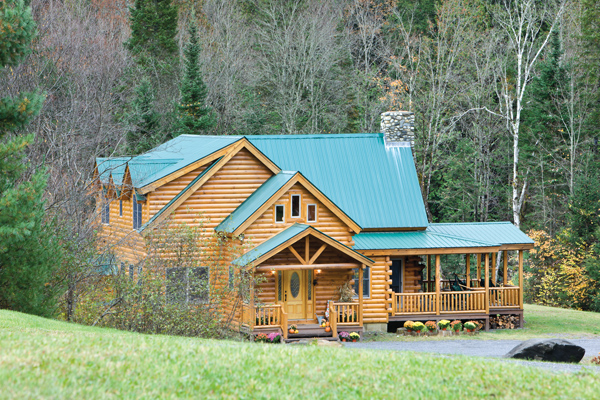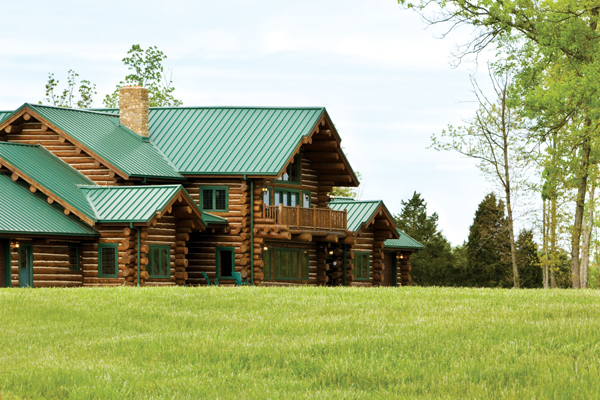The adventure of building your own log or timber frame home is a rewarding and possibly once in a lifetime experience. Keeping that home in tip-top shape is an ongoing process that begins with the first conversations concerning materials and design. Then, when the home is complete, you should take the initiative to ensure that a long-term maintenance plan is in the works.
“Take time to research the options for maintenance products,” urges Barbara Murray, owner of CTA Products Group. “Call the manufacturers. There are big differences between the various maintenance products available.” Keeping the structural integrity of the log home at its peak does require the proper application of protective products, and finding the right ones involves consultation. Factors such as climate, type of wood, potential insect infestation, and cost make the effort to determine the best products for your home worthwhile.
“Finding a complete system of compatible log home care products for your home that will be cost effective, time saving, and long lasting is key,” explains Kevin Piatz, a log home specialist with Perma-Chink Systems, Inc. “Find a system of products that works well with any climate. Understand that the air temperature as well as the ambient temperature of your wood can affect product application. Check with the manufacturer of your log or timber frame products for specific ways this may vary. The moisture content of your wood can also be a factor. Eighteen percent moisture is a good place to start if the system you are working with is breathable. Always ask the manufacturer.”
Calculating cost and time involved when making product choices leads to savings and application efficiency. “When doing your research, ask for samples of products,” continues Piatz. “How many lineal feet will you get out of a pail of the sealant or chinking that you use? How many square feet of coverage will you get from a gallon of finish? Sometimes the more moderate or even higher priced products are a better value because they go further than the cheaper ones. This is worth considering. Prep is always the number one thing when sealing or staining. Always follow the manufacturer’s recommendations. If you hire a contractor, make sure that they have a solid background. Check their references and make sure they are current with their insurance company. Then get quotes from more than one contractor.”
As for the design of the home, take a moment to make sure that this element itself does not contribute to future issues. “Decide on the best brand and type of caulking and stain, water or oil based, that will be easiest to maintain and reapply,” advises Tom Wyles, founder and chief executive officer of Tomahawk Log & Country Homes, Inc., “and be sure that you have overhangs of about two feet all around the home so log corners aren’t exposed to the weather or rain off the roof. It may also be a good idea to be sure that the bottom frames of windows have a tilt to allow water to run off and away from a wall.”

Coventry Log Homes/photo by Roger Wade
Murray agrees. A maintenance-friendly design means better performance and enduring structural integrity into the future. “Make sure there are no built-in design flaws that will contribute to unnecessary future maintenance. Plan for gutters where needed. Keep the first course of logs well off the ground. A reputable manufacturer will help guide you in the initial design phase to eliminate or substantially reduce future maintenance issues.”
A good rule of thumb with that first course of logs is to build it at least 18 inches above ground to keep insects away and reduce splashback damage to logs. Piatz adds, “Vegetation can make it easier for bugs to have access to your building and can scratch against the walls, damaging the finish. Keep your firewood as far away from your home as you can. Wood stacked against your walls or on your porch is another route for bugs to infiltrate. Made sure you seal around the windows and doors, between the sill log and the foundation, and between the final log and the roof. Use products specifically created for log and timber frame home care and stick within a single system of compatible products.”
Log and timber frame home owners often miss the best opportunities to minimize potential maintenance issues in the beginning, so giving some thought to the action plan early pays off later. “Don’t let any wood go without staining so long that it begins to discolor,” notes Wyles. “Don’t try to skimp on the amount of log oil or stain used. A cloudy or cool day allows it to soak in better, which help it last longer.”
Murray reminds homeowners that most lenders require that a new home be completed before the final paperwork is signed. She offers that completion includes the application of a finish coat of protectant to the exterior. However, she also reminds everyone that most finishes cannot be applied until outdoor temperatures are steadily above 50 degrees. There are exceptions, “But that is where the research comes in!” she cautions.
The importance of a good maintenance regimen from the outset cannot be overemphasized. Wyles advises to be proactive early. “If you start out that way, you increase the time before you will need to strip the exterior and start over again, and it will look better longer. You will save time and money in the long run. Extra coats of protective stain or oil may be a good idea, especially on the first foot or two above open decks where rain, snow, and reflected heat can accelerate the life of a stain or oil.”
Do the research. Remember the details. Take the time. Each of these cautionary steps will result in the establishment of a maintenance routine and schedule that prolong the life of a log and timber frame home, reduce the likelihood of surprises and the associated costs, and result in the look and feel of quality for which all homeowners strive.
Photography by Roger Wade Studio

